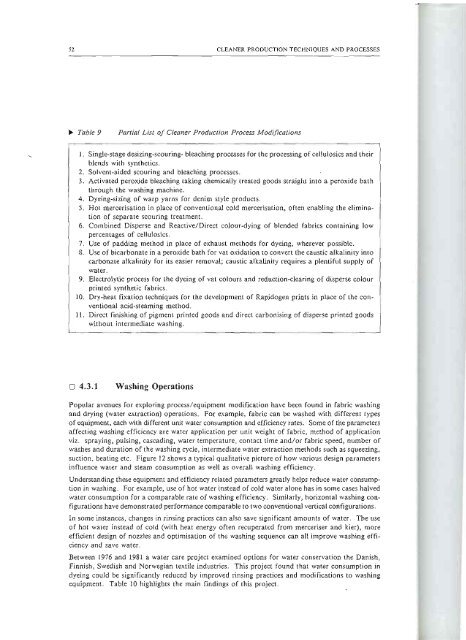Contributor, The Textile Industry and the Environment, UNEP
Contributor, The Textile Industry and the Environment, UNEP
Contributor, The Textile Industry and the Environment, UNEP
You also want an ePaper? Increase the reach of your titles
YUMPU automatically turns print PDFs into web optimized ePapers that Google loves.
52 CLEANER PRODUCTION TECHN1QUES AND PROCESSES<br />
.. Table 9 Partial List 0/ Cleaner Production Process Modifications<br />
1. Single--stage desizing-scouring- bleaching processes for <strong>the</strong> processing of cellulosics <strong>and</strong> <strong>the</strong>ir<br />
blends with syn<strong>the</strong>tics.<br />
2. Solvent-aided scouring <strong>and</strong> bleaching processes.<br />
3. Activated peroxide bleaching taking chemically treated goods straight into a peroxide bath<br />
through <strong>the</strong> washing machine.<br />
4. Dyeing-sizing of warp yarns for denim style products.<br />
5. Hot mercerisation in place of conventional cold mercerisation, often enabling <strong>the</strong> elimination<br />
of separate scouring treatment.<br />
6. Combined Disperse <strong>and</strong> Reactive/Direct colour-dying of blended fabrics containing low<br />
percentages of cellulosics.<br />
7. Use of padding method in place of exhaust methods for dyeing, wherever possible.<br />
8. Use of bicarbonate in a peroxide bath for vat oxidation to convert <strong>the</strong> caustic alkalinity into<br />
carbonate alkalinity for its easier removal; caustic alkalinity requires a plentiful supply of<br />
water.<br />
9. Electrolytic process for <strong>the</strong> dyeing of vat colours <strong>and</strong> reduction-clearing of disperse colour<br />
printed syn<strong>the</strong>tic fabrics.<br />
10. Dry-heat fixation techniques for <strong>the</strong> development of Rapjdogen prints in place of <strong>the</strong> conventional<br />
acid-steaming method.<br />
11. Direct finishing of pigment printed goods <strong>and</strong> direct carbonising of disperse printed goods<br />
without intermediate washing.<br />
o 4.3.1 Washing Operations<br />
Popular avenues for exploring process/equipment modification have been found in fabric washing<br />
<strong>and</strong> drying (water extraction) operations. For example, fabric can be washed with different types<br />
of equipment, each with different unit water consumption <strong>and</strong> efficiency rates. Some of <strong>the</strong> parameters<br />
affecting washing efficiency are water application per unit weight of fabric, method of application<br />
viz. spraying, pulsing, cascading, water temperature, contact time <strong>and</strong>/or fabric speed, number of<br />
washes <strong>and</strong> duration of <strong>the</strong> washing cycle, intermediate water extraction methods such as squeezing,<br />
suction, beating etc. Figure 12 shows a typical qualitative picture of how various design parameters<br />
influence water <strong>and</strong> steam consumption as well as overall washing efficiency.<br />
Underst<strong>and</strong>ing <strong>the</strong>se equipment <strong>and</strong> efficiency related parameters greatly helps reduce water consumption<br />
in washing. For example, use of hot water instead of cold water alone bas in some cases halved<br />
water consumption for a comparable rate of washing efficiency. Similarly, horizontal washing configurations<br />
have demonstrated performance comparable to two conventional vertical configurations.<br />
In some instances, changes in rinsing practices can also save significant amounts of water. <strong>The</strong> use<br />
of bot water instead of cold (with heat energy often recuperated from merceriser <strong>and</strong> kier), more<br />
efficient design of nozzles <strong>and</strong> optimisation of <strong>the</strong> washing sequence can all improve washing efficiency<br />
<strong>and</strong> save water.<br />
Between 1976 <strong>and</strong> 1981 a water care project examined options for water conservation <strong>the</strong> Danish,<br />
Finnish, Swedish <strong>and</strong> Norwegian textile industries. This project found that water consumption in<br />
dyeing could be significantly reduced by improved rinsing practices <strong>and</strong> modifications to washing<br />
equipment. Table 10 highlights <strong>the</strong> main findings of this project.

















